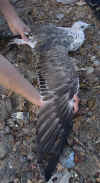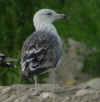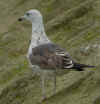 nominate Lesser Black-backed Gull (L. fuscus)
nominate Lesser Black-backed Gull (L. fuscus)
(last update:
| 2cy fuscus: August
In 2cy nominate fuscus, there is a large variety in moult stage in August and it's hard to describe a 'typical' plumage for this age class. The images right illustrate the variation from slightly delayed moult, to 'average' and well-advanced birds. Especially the latter group bears a strong resemblance to 3cy birds from the western graellsii and intermedius populations in general appearance. So far, this page contains images from a short trip to Stockholm, Sweden and to the landfill of Tampere, Finland in August 2002. There are a few points, which can be found more often in fuscus than in graellsii/intermedius, on population level and may give some clues as to the specific identification in some characteristic birds. Note however that single individuals from graellsii, intermedius and fuscus are almost impossible to tell apart as there exists a large overlap. For comparison, have a look at the images of ringed graellsii and unidentified graellsii / intermedius presented in the Lesser Black-backed Gull sections of August, September, October and November-December and on the page "Discusfus". Primary moult stage Prior to northbound migration all or nearly all primaries were moulted to second generation flight feathers on the wintering grounds. From February to May 2cy fuscus moult all (or nearly all) primaries to second generation feathers at the wintering grounds. The complete month of June is used to migrate north. Lars Jonsson, in Birding World (1998 Vol. 11 No. 8) mentions the arrival date in Scandinavia as pretty standard "arriving promptly around 1st of July on Gotland". Identification of 2cy fuscus is easier if there are still juvenile outer primaries (arrested primary moult), especially when a new moult wave starts at P1. Juvenile P10 is never present in 3cy graellsii or intermedius.
Secondaries and rectrices On first glance the average 2cy fuscus seems to have moulted the complete tail and all of the secondaries on the wintering grounds. By August the tail-feathers appear already worn at the tips and the brown sub-terminal band might be slightly bleached towards paler brown. This is in line with the statement of Jonsson: "Although it is more difficult to judge in the field how many of the secondaries have been moulted, they generally appear to be largely moulted, but a few juvenile secondaries sometimes remain". The number of observation of fuscus in Finland (in our case) are too low to draw any conclusions, but at least one bird had some inner secondaries still juvenile (the only 2cy bird we caught). The tail-feathers are easily judged in the field and appeared second generation in all 2cy birds. Wing-covert moult It's again the kind of birds represented in image 3598 that show most juvenile wing-coverts, especially the upper rows of lesser coverts, the carpal edge (outer lesser coverts) and the central greater coverts, which are moulted in descending order. However, the average fuscus has all wing-coverts moulted on the wintering grounds prior to northbound migration and those second generation feathers appear already pretty bleached with paler brown centres and abrasion on the fringes. Quite some birds were missing the outer median coverts, indicating they started a partial moult again, continuing to replace wing-coverts for the second time and grow in third generation feathers. In general these third generation feathers are all dark, blackish and can be found in almost all the images presented on the right-hand side. Advanced birds show many third generation wing-coverts, as can be seen in images 3323 and 3353: Most of the median coverts, the inner greater coverts, most of the lower lesser coverts and the outer lower lesser coverts have been replaced by third generation coverts. As can be seen in the images, the old second generation wing-coverts are bleached and abraded at the fringes. Literature Lars Jonsson (1998), "Baltic Lesser Black-backed Gull Larus fuscus fuscus moult, ageing and identification", in Birding World Volume 11 number 8, 1998. Visa Rauste (1999), "Kennzeichen und Mauser von "Baltischen Heringsmöwen" Larus [fuscus] fuscus und "Tundramöwen" L. [fuscus] heuglini", in Limicola 13 1999. |
 LBBG fuscus 2cy, August 04 2002, Stockholm, Sweden.
Flying over the centre of Stockholm. Only small numbers of 2cy bird are present early August at the northern breeding grounds. LBBG fuscus 2cy, August 04 2002, Stockholm, Sweden.
Flying over the centre of Stockholm. Only small numbers of 2cy bird are present early August at the northern breeding grounds. |
|
RINGED 2CY FUSCUS |
|
 LBBG
fuscus 2cy C5UJ, August
08 2002, Tampere, Finland (61.33N 24.59E). Average 2cy fuscus in Finland. Primaries
P1-P9 repalced. The picture shows the abraded tip
of P10. LBBG
fuscus 2cy C5UJ, August
08 2002, Tampere, Finland (61.33N 24.59E). Average 2cy fuscus in Finland. Primaries
P1-P9 repalced. The picture shows the abraded tip
of P10. |
|
 LBBG
fuscus 2cy C6XV, August
07 2002, Tampere, Finland (61.33N 24.59E). Post-juvenile moult
complete: this bird returned to Scandinavia
with 10 second generation primaries. LBBG
fuscus 2cy C6XV, August
07 2002, Tampere, Finland (61.33N 24.59E). Post-juvenile moult
complete: this bird returned to Scandinavia
with 10 second generation primaries. |
|
 LBBG
fuscus 2cy CNMR, August
10 2002, Tampere, Finland (61.33N 24.59E). Average 2cy fuscus in
Finland. Moulting inner primaries, outer median and lower lesser coverts
& scapulars. Ringed as 2cy fuscus on August 10 2002, ringed white
CNMR and metal HT-238.599. Seen again as 3cy. LBBG
fuscus 2cy CNMR, August
10 2002, Tampere, Finland (61.33N 24.59E). Average 2cy fuscus in
Finland. Moulting inner primaries, outer median and lower lesser coverts
& scapulars. Ringed as 2cy fuscus on August 10 2002, ringed white
CNMR and metal HT-238.599. Seen again as 3cy. |
|
|
DELAYED 2CY FUSCUS PLUMAGES |
|
 LBBG
fuscus / intermedius / heuglini 2cy, August 08 2002, Tampere, Finland
(61.33N 24.59E). Stocky appearance. This bird may represent the
strongest built fuscus, but may otherwise represent intermedius
or heuglini in 2cy. LBBG
fuscus / intermedius / heuglini 2cy, August 08 2002, Tampere, Finland
(61.33N 24.59E). Stocky appearance. This bird may represent the
strongest built fuscus, but may otherwise represent intermedius
or heuglini in 2cy. |
|
 LBBG
fuscus 2cy, August 09 2002, Tampere, Finland
(61.33N 24.59E). Different from average fuscus in delayed wing-covert and primary moult. It's
difficult to fully exclude intermedius in these kind of birds. LBBG
fuscus 2cy, August 09 2002, Tampere, Finland
(61.33N 24.59E). Different from average fuscus in delayed wing-covert and primary moult. It's
difficult to fully exclude intermedius in these kind of birds. |
|
|
AVERAGE 2CY FUSCUS PLUMAGE |
|
 LBBG
fuscus 2cy, August 06 2002, Tampere, Finland
(61.33N 24.59E). Secondaries and rectrices are worn second generation. P1 shed, P2-P10 second
generation. Strong & bulky fuscus is hard
to distinguish from 3cy intermedius.
Best clue: fresh outer primaries. LBBG
fuscus 2cy, August 06 2002, Tampere, Finland
(61.33N 24.59E). Secondaries and rectrices are worn second generation. P1 shed, P2-P10 second
generation. Strong & bulky fuscus is hard
to distinguish from 3cy intermedius.
Best clue: fresh outer primaries. |
|
 LBBG
fuscus 2cy, August 09 2002, Tampere, Finland (61.33N 24.59E). Relatively low number of fresh blackish scapulars.
Pale iris. LBBG
fuscus 2cy, August 09 2002, Tampere, Finland (61.33N 24.59E). Relatively low number of fresh blackish scapulars.
Pale iris. |
|
 LBBG
fuscus 2cy, August 07 2002, Tampere, Finland (61.33N 24.59E).
Strong and powerful bird with a relatively low number of fresh blackish
scapulars and wing-coverts. Rather pale iris. LBBG
fuscus 2cy, August 07 2002, Tampere, Finland (61.33N 24.59E).
Strong and powerful bird with a relatively low number of fresh blackish
scapulars and wing-coverts. Rather pale iris. |
|
 LBBG
fuscus 2cy, August 03 2002, Stockholm, Sweden. Fuscus with new central median and
lower lesser coverts. Outer primaries all included in the
post-juvenile primary moult. LBBG
fuscus 2cy, August 03 2002, Stockholm, Sweden. Fuscus with new central median and
lower lesser coverts. Outer primaries all included in the
post-juvenile primary moult. |
|
 LBBG
fuscus 2cy, August 03 2002, Stockholm, Sweden. Second
primary moult started:
P1-P2 missing, P3-P9 second generation and P10 still juvenile. LBBG
fuscus 2cy, August 03 2002, Stockholm, Sweden. Second
primary moult started:
P1-P2 missing, P3-P9 second generation and P10 still juvenile. |
|
 LBBG
fuscus 2cy, August 04 2002, Stockholm, Sweden. Advanced tail-feather
replacement: a few all-white feathers by August. LBBG
fuscus 2cy, August 04 2002, Stockholm, Sweden. Advanced tail-feather
replacement: a few all-white feathers by August. |
|
 LBBG
fuscus / intermedius 2cy, August 04 2002, Stockholm, Sweden.
Second generation tail-feathers show prominent white tips, probably moulted after arrival in
Scandinavia. Second generation P8 levels P7, P10 still juvenile. LBBG
fuscus / intermedius 2cy, August 04 2002, Stockholm, Sweden.
Second generation tail-feathers show prominent white tips, probably moulted after arrival in
Scandinavia. Second generation P8 levels P7, P10 still juvenile. |
|
 LBBG
fuscus 2cy, August 06 2002, Tampere, Finland (61.33N 24.59E). P1-P2 missing.
Small pale
crescents on fresh outer primary tips. Extensive head streaking and moult in neck, side breast and under-parts. LBBG
fuscus 2cy, August 06 2002, Tampere, Finland (61.33N 24.59E). P1-P2 missing.
Small pale
crescents on fresh outer primary tips. Extensive head streaking and moult in neck, side breast and under-parts. |
|
 LBBG
fuscus 2cy, August 09 2002, Tampere, Finland (61.33N 24.59E).
Average 2cy bird. Shed P1 and P2 after arrival in Scandinavia. LBBG
fuscus 2cy, August 09 2002, Tampere, Finland (61.33N 24.59E).
Average 2cy bird. Shed P1 and P2 after arrival in Scandinavia. |
|
 LBBG
fuscus 2cy, August 07 2002, Tampere, Finland (61.33N 24.59E).
Median
covert moult in progress and tertial #1 missing. Tail
completely second generation. LBBG
fuscus 2cy, August 07 2002, Tampere, Finland (61.33N 24.59E).
Median
covert moult in progress and tertial #1 missing. Tail
completely second generation. |
|
 LBBG
fuscus 2cy, August 09 2002, Tampere, Finland (61.33N 24.59E).
Tertials worn second generation in the left wing, but in the right
wing the upper tertial has been dropped. 70% of scapulars replaced for adult-like plain dark grey scapulars. LBBG
fuscus 2cy, August 09 2002, Tampere, Finland (61.33N 24.59E).
Tertials worn second generation in the left wing, but in the right
wing the upper tertial has been dropped. 70% of scapulars replaced for adult-like plain dark grey scapulars. |
|
|
ADVANCED 2CY FUSCUS PLUMAGES |
|
 LBBG
fuscus 2cy, August 07 2002, Tampere, Finland (61.33N 24.59E).
Strong & powerful bird in the field. Pale pink
bill-base with dark tip. LBBG
fuscus 2cy, August 07 2002, Tampere, Finland (61.33N 24.59E).
Strong & powerful bird in the field. Pale pink
bill-base with dark tip. |
|
 LBBG
fuscus 2cy, August 07 2002, Tampere, Finland (61.33N 24.59E).
Secondaries second generation, P1-P2
replaced third generation, P3 missing & P4-P10 second
generation, moulted in the post juvenile moult last winter. LBBG
fuscus 2cy, August 07 2002, Tampere, Finland (61.33N 24.59E).
Secondaries second generation, P1-P2
replaced third generation, P3 missing & P4-P10 second
generation, moulted in the post juvenile moult last winter. |
|
